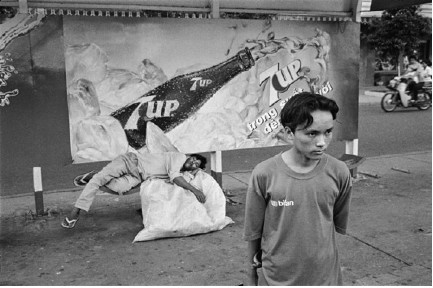back to Vietnam Series
These images were commissioned by povertyticker.com formerly known as Make Poverty History in July 2006. As this is a fairly recent project, I am only able to supply the reader with a proposal for this commissioned work. - Marco Bohr
Make Poverty History Proposal for Photographs from Vietnam
Just a few days after the announcement that we are invited to propose projects for Make Poverty History I came across the following article in the Wall Street Journal:
Intel announces 300-million-dollar chip factory for Vietnam, Feb 28, 2006
Ho Chi Minh City, Vietnam - US computer chip giant Intel Corp announced Tuesday it will build a 300-million-dollar chip assembly factory in Vietnam, a huge boost to Vietnam's ambitions to become a new player in high-tech industries and a sign of how relations have changed between the former wartime enemies […].
Vietnam's economy grew at a blistering 8.4 per cent last year, perhaps the second-fastest growing economy in the world behind China. Still, the country needs high growth rate to provide jobs for more than 1 million young people entering the workforce each year. Vietnam last year attracted 6 billion dollars in foreign direct investment, more in dollar terms than India and more per capita than China.The conclusion of the article is that Vietnam is one of the fastest growing economies not in Southeast Asia but in the whole world. That was not contested by preliminary research I conducted on poverty in Vietnam. Shirley Brady from IISD's Developing Ideas writes in 2005:
Despite being widely touted as Asia's next 'economic tiger', Vietnam is still among the poorest nations in the world. A World Bank report on poverty, released this spring, pegs the average annual income at less than US$240 per person, and a government report released in May estimates that 22% of households are poor and hungry. As the world's third largest exporter of rice, Vietnam calculates 'poor' as families unable to purchase 13 kg of rice per person each month, and 'hungry' as less than 8 kg.
This is just one more example why I have always thought of Vietnam being a country full of paradoxes. In the West, the negative connotation of war is still widely attached to the name of the country, which has been at peace for nearly three decades. Curiously enough, the Vietnam War is called the American War within its boundaries. The scars of war are probably as apparent as they are on the splitter bomb marks on the Victoria and Albert Museum in London – as if they were from a different era altogether.
Communist Vietnam has achieved remarkable economic success since the doi moi (renovation) process began almost twenty years ago. In the beginning of the 21st century, Vietnam is a highly industrialized and booming country whose citizens theoretically have access to electronics, telecommunications, Internet, automobiles and anything else a functioning consumer society has to offer. Yet, it remains communist, which once again draws quite a different picture in comparison to countries such as Cuba or even North Korea.
The uncomfortable relationship between an ever-booming economy and one of the lowest annual incomes in the world shall be a major focus in my photographic work. With my images of contemporary Vietnam (can one even think of contemporary images from Vietnam) I wish to explore the idea that huge investment and economic growth don’t necessarily imply wealth for everyone. In fact, cities such as Ho Chi Minh and Hanoi have experienced a building phenomenon that has similar occurrences in South Africa and Brazil called “Rich Ghettos”. It is possible that I will portray wealth for this project as well as poverty to point out the widening gap between both.
 |
| Foreign penetration can now be observed everywhere in Viet Nam. Poster on a bus stop in Ho Chi Minh City that provides shelter from the sun and rain and a place for the weary to rest. The product, which some claim causes bone weakening, tooth decay and obesity, is unpopular as it makes the drinker thirsty. – Philip Jones Griffiths |
Certainly, the juxtaposition of western advertisement in a nation where one third lives below the poverty level should be visual indicators of the paradoxes of a globalized world. Above photograph by acclaimed Magnum photographer Philip Jones Griffiths is a perfect example of the schizophrenic logics of rapid economic growth in a country where most survive on less than one dollar a day. Also, in my past projects in Canada, Japan, and Scotland I often let myself be guided by outside circumstances and sincerely hope that I am also given the opportunity for this project I am very enthusiastic about.
Marco Bohr, 2006
back to Vietnam Series